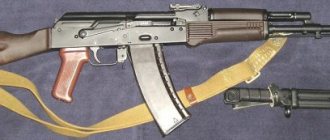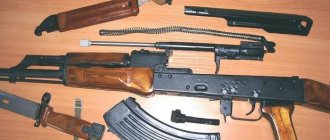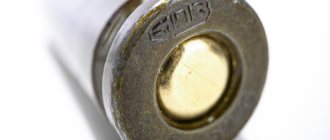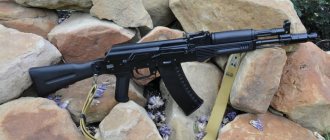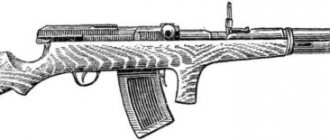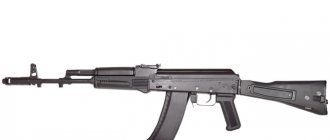The history of the creation of the Kalashnikov AK 203 assault rifle
This machine gun was first presented at the international forum “Army-2018”, which took place in Kubinka. The public presentation took place at an exhibition of weapons for law enforcement agencies in the Moscow region in the same year. We were talking about new generation Kalashnikov assault rifles. Models of the 200 series were presented. At the beginning of 2022, this model received export permits.
This generation began to be developed in 2008-2009 by IZHMASH OJSC, which in 2013 was renamed Kalashnikov Concern. However, after a few years, work was temporarily stopped. In 2015, in connection with the development of automatic machines of the four hundredth series, work continued on the creation of the two hundredth. The first model that was created was the AK-200. Development also took place as part of the "Kobves" development project. This machine was developed on the basis of the hundredth series.
This machine has gained a high reputation in the world. India is planning to switch to the AK-203 from the assault rifle they currently have in service. An agreement was reached not only on the supply of more than 700 thousand AK-203 assault rifles, but also on the construction of factories in this country that should produce them.
The AK-203 is one of the descendants of the famous AK-47, which entered service immediately after the Great Patriotic War. Formally speaking, the first model was the AK-46, which was actually a prototype weapon.
In the 50s, the next stage in the evolution of the machine gun took place. AKM (modernized AK) appears. It was adopted by the army in 1959. One of its advantages was an increase in the target firing range to 1000 m.
In the 70s, there was a need to switch to a smaller caliber. This is due to the reduced weight of the weapon and the lack of need for excess power of the 7.62 mm cartridge. During this period, the AK-74 was developed. The speed of the bullet has increased, and the recoil has become less. At this time, they began to switch to using plastic stocks instead of wooden ones. This led to a reduction in the weight of the weapon. Options were developed for special purpose units (model AKS-74) and for use in night conditions. The latter allowed the use of an optical sight for shooting in the dark (Model AK-74N).
The first model of the fourth generation was the modernized AK-74 (AK-74M). The hundredth series was developed on its basis. It developed models for several calibers: 7.62 (AK-103, AK-104), 5.56 (AK-101, AK-102) and 5.45 mm (AK-105). AK-105 was supplied to Russian security forces, and AK numbers 101-104 were intended for export.
The first assault rifle of the 200 series is considered to be the AK-12. It was created as part of the “Ratnik” kit for the future soldier. This model has incorporated all previously made developments and advantages. It combined relative cheapness, simplicity and reliability, as well as high efficiency. Soon after this, the AK-15 model appeared.
In 2016, information appeared in the press about the development of small arms of the 300 series, but not a single model with this number was created. Work on this generation soon ceased. Instead, the 100th series machines were modernized. The results of the work were officially presented in 2022. A year later, these modernized machines received a new name and began to be part of the 200th series.
The general director of the Kalashnikov concern said that the production of assault rifles of this series is the company’s strategy in the coming years in the export direction. Production of the civilian version of the AK-203 also began.
Low-impulse 74th
Weapons progress does not stand still. Thus, as a result of the Vietnam War, a new American low-pulse 5.56 mm cartridge entered the world stage, and the AK had its main competitor - the M-16 rifle. We will leave aside discussions about the benefits and harms of such cartridges; to this day, gun lovers are breaking their heads, discussing the practice of using them, but have not decided which cartridge is better. But the USSR did not remain aloof from new weapons trends.
AKM with PBS
Source: pinterest.ru
In 1974, the AK-74 appeared, adapted for the Soviet low-pulse cartridge 5.45x39 mm. It was still the same machine gun that was familiar to us, which acquired characteristic differences in the form of a more direct magazine, which no longer resembled a “horn,” and an elongated DTK.
AKS-74
Source: pinterest.ru
The AK-74 had several versions, including the AKS-74 - with a folding frame stock, but on the left side, and the 74N - for using night sights. There is also a completely modern version of it - the AK-74M, in which the wooden parts of the stock and butt were replaced with polymer ones, and the full-size butt, which was called a “paddle” for its length, also “learned” to fold to the side. The AK-74 has retained and increased all the attachment options inherited from the AKM, and the dovetail on the left side of the receiver, which allows the installation of a full range of sights - both full-size and modern - on the Picatinny rail.
AKSU
Source: pinterest.ru
Separately, we need to mention the AKSU - a shortened assault rifle that we can see on police officers. Developed in 1979, AKSU performed well as a compact assault rifle. At the same time, it surpasses submachine guns in terms of cartridge power and firing range. Initially, it was intended to arm airborne units and “non-core” units (where fire contact with the enemy is not implied) - gunners, drivers and others. But during its operation, the AKSU fell in love with the police, special forces, KGB officers - in general, all those for whom stealth, high firepower and mobility of automatic weapons are very important. Produced in millions of copies, and having survived the Afghan War and local conflicts on the territory of the former USSR, the 74th series assault rifles have earned the respect and love of fighters.
Performance characteristics of the Kalashnikov AK 203 assault rifle
| Characteristic | Parameter |
| Caliber | 7.62 mm |
| Barrel length | 410 mm |
| Barrel type | threaded |
| Ammunition type | 7.62x39 |
| Magazine capacity | 30 |
| Shot speed | up to 140 m/s |
| Rate of fire | 600 rounds per minute |
| Length with stock folded | 705 mm |
| Weight with empty magazine | 4.1 kg |
All models of the 200 series use automation that operates using waste powder gases. Locking occurs by turning the bolt. With the butt folded, the length of the machine gun is slightly more than 70 cm.
The barrel has a length of 415 mm, which provides good bullet penetration. The weight of a weapon with an empty magazine is 4.1 kg. The machine's rate of fire reaches 600 rounds per minute. The magazine holds 30 rounds.
In service
Back in 2015, the AK-12 was chosen as the automatic weapon for the Ratnik outfit. The military was attracted by the price and quality of the weapon. The direct competitor A545 was a significant loser in this regard - it is technologically more complex and many times more expensive. It's not worth the trouble.
Shooting from AK-19
On January 29, 2022, the AK-12 was adopted by the Airborne Forces, Marine Corps and Ground Forces. His brother. The AK-15 has been adopted by special forces of the army and other security forces.
By 2022, the Kalashnikov concern should supply approximately 112,000 AK-12 units to the Russian Defense Ministry. The contract is currently valid until 2022. Time will tell further.
Structure of AK 203
The layout of the components of the AK-203 is similar to the AK-74M and AK-12. This weapon has the index 6P45. In automation, a long stroke of the gas piston is used. Locking occurs with a rotary bolt. The fire switch between single and automatic and at the same time the fuse is located on the right side of the box. It has a shelf that allows you to switch with one finger.
The barrel contains four rifling, running left, up and right. It is made from weapon grade steel.
The receiver is stamped. It consists of two parts: the receiver itself and its cover. Its front cover is secured with a hinge, and in the back there is a latch that can be controlled using a lever.
The box has four guides along which the shutter moves. When locked, it interacts with the cutouts located in the front. This design makes the weapon more reliable, but at the same time makes it heavier.
The bolt group consists of the following parts: bolt, bolt carrier, firing pin and ejector. They are located in such a way that they work reliably even in conditions of heavy pollution. The bolt frame ensures reloading and automatic operation of the weapon.
The bolt has two protrusions that fit securely into special cutouts in the receiver. Entering special grooves in the receiver, they reliably lock the barrel and allow you to fire a shot. A device for ejecting the cartridge case is attached to the bolt. The return mechanism is designed to ensure that the bolt group takes the extreme forward position.
The Picattini rail is located on the top side of the receiver. It is adapted for attaching additional devices to increase shooting efficiency. Additionally, such strips are made on the forend. They are located below and on the sides.
A trigger-type mechanism is used as a trigger mechanism. It uses a U-shaped mainspring made from triple twisted wire. This mechanism provides for the use of three axes: for the trigger, self-timer and trigger.
A barrel slotted flame arrester with a compensator is provided. A folding stock is used. This makes carrying the weapon more convenient. It is folded to the left. The stock has high strength. It can be used for hand-to-hand combat. It is possible to install an under-barrel grenade launcher or a bayonet.
The AK-203 magazine holds 30 rounds. Its design includes the following parts: cover, feeder spring, housing and locking strip. The magazine used is believed to be highly reliable. The fastening unit does not use a developed neck. The magazine is connected to a special hole in the receiver, hooked to the front edge of the hole, and then snapped into place.
Firing accuracy is ensured by the use of a mechanical sighting device. The sighting bar is marked up to a distance of 800 m. The rear sight is located on the mane of the sight, and the front sight is on the muzzle of the barrel. Tactical silencers may be included in the package.
200th AK series - a look from both sides
What is known about the new machine is that the 200 series will have a 40-50% advantage in efficiency compared to previous models. As follows from Grodetsky’s statement, the new machine gun will have a strap that is designed to mount additional equipment - laser designators, sights and a flashlight.
The modernized Kalashnikov, marked 74 and with a caliber of 5.45 millimeters, has a side-folding plastic stock and a dovetail bar, which is designed for attaching optical sights. The rate of fire of the AK-74M is within 600 rounds per minute. This machine gun was put into service in 1995.
The original model of the Kalashnikov assault rifle was developed in 1947 and just two years later the Soviet Army adopted it for service. Over time, the Kalashnikov was improved, new modifications appeared, the newest was still considered the “hundredth series” (includes models from AK-101 to AK105), which appeared in the 90s. Kalashnikov assault rifles were adopted in 55 countries. Some states, for example, China, are engaged in the manufacture of Kalashnikovs without a license.
Below we present two views, two positions on this world-famous machine. The first look at the machine gun will be a look at the modified Kalashnikovs, which were produced by the American company Krebbs custom guns. The order for this company was placed by still unknown entrepreneurs from Iraq. The second look will be the local Izhevsk automatic machine, the review of the models will be provided with comments from Comrade. Fox. The mentioned comrade Lis was a member of the Afghan company and worked at the Rzhev test site for a long time.
Comrade Lees notes that during his service in Afghanistan, he used a Krebbs Kalashnikov, which was delivered from the enemy camp. According to him, the impressions of using this machine can be compared with the impressions of using a new imported car after a Russian one. However, the estimated cost of such weapons is quite high.
There were no comments regarding the Kalashnikovs produced at the Izhevsk plant, but the silence was significant.
So we see:
A certain number of picattini rails have been added to the new machine gun, the handle has been made more or less ergonomic, a safety has been added under the thumb of the right hand, which, unfortunately, is in no way connected with the standard safety-translator, but simply locks the trigger.
The machine was made simply and, perhaps, a little crudely; as they say, it was assembled on the knee. The production of such products is acceptable for a small company that creates its models in small premises and does not have competent staff. However, for the development plant this is simply unacceptable. It should be noted that the bar fits normally and quite firmly on the gas outlet tube.
The receiver cover, which is located on the other side of the rail in the front part, is mounted on an axis, and in the rear part there is a contactor, somewhat reminiscent of the designs on the SVD or Valmet.
Together, this should provide a consistent fit for the receiver cover once opened. Most likely, this design eliminates the need to align the sighting devices mounted on the cover bar each time after cleaning. There are colored dots on the bar that indicate mounting locations for different types of sights.
The fit of the cap on the axle is made possible by a redesigned open sight assembly. The machine block remained the same, but the bar was shortened and instead of a clamp and a pattern sector, a drum with an eccentric was installed. In this regard, the bar became shorter and the possibility of installing a hinge for the receiver cover became available.
The new model has a cleaning rod in the butt. In addition, a swivel was added to the butt.
It is necessary to distinguish between the desire to correct the shortcomings of the AK and the desire to make the machine gun only an external resemblance to the foreign MASADA, AR15, Stg552. Based on this, we need to develop future models.
For example, the Krebs company creates from an AK exactly the external resemblance of an AR15, and this is due to the nature of demand in the American civilian market.
It would be appropriate to remember the words of Gabe and Suarez: “there is no need to make an M16 rifle out of an AK.” This quote suggests that you should not confuse the purpose and technology of different types of weapons. You should not add a heavy, non-ergonomic body kit to Kalashnikovs, just for show.
What fundamental shortcomings does the AK have that are worth thinking about in the new millennium?
Low shooting accuracy (compared to Western rifles) with single shots. Significant recoil and bounce, especially in 7.62 Difficulty installing optics. Non-ergonomic standard handle. Lack of magazine neck. No automatic shutter delay. Non-ergonomic stock Non-ergonomic safety Inadequate standard mechanical sight (although this point may be controversial).
So, let's look at each point in more detail.
Accuracy of a single fire. This point is determined not so much by the shortcomings of the model, but by poor-quality production, since you can find copies both heaped and very poorly heaped. This means it’s all about the quality of factory production, which needs to be improved.
Recoil and toss. Changing the mass of moving parts, caliber or automatic operation scheme will not lead to improvement, but to the creation of a new rifle. To reduce recoil and flip, it is necessary to use active and reactive muzzle recoil reduction devices. These devices are well developed in the Russian FPSR, and are used by many on 7.62 machines. Therefore, introducing the optimal compensator into mass production is the best solution.
Installation of optics. Since the AK46-1 “turned over” and acquired a classic layout, this issue has been problematic for the AK. However, this problem can be solved, but to solve it it is necessary to understand what optics will be used. The most optimal are the Aimpoint T1 and Aimpoint H1 collimators, the latest versions of EOTech (but they are inferior to the previous ones in size and power consumption). How to install such a sight? The answer is clear - an Ultimak gas outlet is needed, and in order to make an analogue of Ultimak from steel, you only need desire. In this way, you can get a sight that is located on the aiming line of the mechanics and through which the mechanics can be seen. At the same time, installing a flashlight is a completely solvable issue; the solution is, for example, installing a flashlight on an Ultimac using a VTOR adapter.
The mania with which the entire modern world hangs Kalashnikovs with rails is absolutely incomprehensible. For what? Do you have so many optics with a Picatinny mount? Or are you going to use a dovetail adapter to attach the Hyperon to the AK? Or, even funnier, a Cobra on a Weaver, having the overall dimensions and energy consumption of a Tefal iron? Damn, rather than destroy your brain, it’s better to stock up on Aimpoints, anyway, in terms of maintenance cost and defect rate, it will be cheaper than Cobra, especially since the cost of one Hyperon is 15 Aimpoints!!!
Standard fire control handle. There is evidence that soldiers of the Special Forces of the Federal Penitentiary Service of the Urals made their own ergonomic handles from wood quite a long time ago and this says a lot. In fact, in this matter no “revolutionary transformations” of the design or similar things are required. It is enough to simply launch commercial handles into production. At the same time, installing such handles (Russian, Israeli or American) takes a small amount of time, and the costs are not high. However, the benefits of this innovation, in terms of the use of AKs, can be significant.
Neck and bolt stop. These are things that are needed for sports, but in order to apply this for armament purposes, the army will require a change in the format of the store, which has remained unchanged for more than 60 years. It becomes clear that such costs are not entirely reasonable; of course, you can convert the machine gun to the NATO standard, copy Masadov’s magazines. However, it is unlikely that anyone would think of purchasing such a modification of the Kalashnikov, with a converted magazine, the cost of which will significantly exceed the cost of existing models.
Butt. The idea of placing a cleaning rod in the stock may seem quite interesting, but it is not a necessary innovation. The existing standard black AK100 stock is self-sufficient, it is universal and does not require any additions. Such as, for example, a slot for the strap of GP30 butt plates, which do not yet exist as such.
Fuse. Is the sacred cow of modern tactics. The standard lever can be used at fairly high speeds. If you use a fuse with a flag similar to Vepr-12, then the removal speed will be at least no less than that of the AR15 fuse. Probably no more innovations are required. However, modifications with a safety on the left side and an action opposite to natural movement are another attempt to convert an AK into an AR15. Essentially, the safety is not used very often and is needed most for carrying a weapon, so the normal switching speed is a completely sufficient option.
Mechanics. This item is the last on the list, but not the last in importance. It is worth noting that when shooting at dusk or quickly transferring fire, the AK rail works and, at the same time, at a fairly high level. At the same time, a tritium insert in the Kalashnikov front sight for shooting in low light conditions could be a completely justified and practical addition. At the same time, the cost of $70 at Brownels allows everyone to use this option. The mechanics of the machine gun do not require research and development and a huge number of straps, just as there is no need for reinforced locking of the receiver cover. Some additions are unnecessary, this should be taken into account.
In conclusion, it should be said that although the new Kalashnikov looks quite impressive in the photograph. In fact, it does not have any fundamental differences from its predecessors. It does not implement a large number of innovations. In particular, these are modified ergonomics. Quite controversial are the charging handle located on the left and the reverse-acting fuse.
Advantages and disadvantages of the model
Advantages and disadvantages
Simplicity and reliability of design
High efficiency in combat conditions
High-quality ergonomics
Possibility of using additional devices: sight, silencer, under-barrel grenade launcher, bayonet, flame arrester and others
Relatively heavy weight
Low shooting accuracy
This machine has been in development for over ten years. Development stopped and then resumed. Over time, the accuracy of fire was improved. The machine has the ability to use an optical sight.
During development, the following tasks were set: to increase the accuracy of fire, to reduce the weight of the machine gun with body kit. High ergonomics allow not only comfortable use of the weapon, but also shooting with one hand.
Two Picattini rails were used, with which you can attach various types of body kit: sights, flashlights or others. The kit includes a bayonet for hand-to-hand combat. It is attached by sliding a ring onto the barrel sleeve. It is additionally attached to the ramrod latch. The blade length is 150 mm.
The following advantages of the weapon are noted:
- High operational reliability even in difficult conditions.
- Although there are comments regarding the accuracy of fire, it has been significantly improved compared to previous models of the machine gun.
- Simplicity of design.
- A distinctive feature of the 200th generation machines is their improved ergonomics.
- Possibility to install modern accessories. There are special strips for their fastening. These include sights, flashlights, an under-barrel grenade launcher, a bayonet knife and others.
It is also necessary to point out existing shortcomings:
- Although the accuracy of fire in this model was improved, it nevertheless remained one of the weak points of the weapon. When firing in bursts, relatively low firing efficiency is noted.
- This machine has a relatively large weight, which is associated with the active use of steel parts in the design. When trying to avoid this, the reliability of the design and the accuracy of shooting are reduced.
- The design uses only two lugs. If there were three of them, this would allow the use of a smaller rotation angle and more reliable locking. For comparison, it makes sense to note that similar Western models use six lugs or more.
- The trigger mechanism parts are located inside the receiver. This makes the mechanism more reliable. However, in some similar weapon models they are designed as a separate unit, which can be easily replaced if necessary.
This machine gun occupies one of the leading positions in the world in its class of weapons, however, the noted shortcomings indicate the need for its further development. Over time, the requirements for weapons are increasing. In order to comply with them, the Kalashnikov assault rifle must be modified accordingly.
Ammunition for the Kalashnikov assault rifle
7.62 caliber cartridges were used for shooting. Their length was 39 mm. One of the requirements when using ammunition is that after penetrating weak barriers, it must retain enough energy to hit the enemy.
This applies to obstacles such as helmets, bulletproof vests that protect against shrapnel, and logs. The 7.62x39 cartridge satisfies these conditions, but is characterized by flight instability after it penetrates an obstacle. Subsequently, such cartridges were modified by hardening the steel core.
Ammunition of various AK models, second from left is a standard 7.62 mm cartridge
Disassembling the machine
Partial or complete disassembly and reassembly of the weapon may be performed. In the first case, the purpose may be to inspect the weapon, clean it or lubricate it. Complete disassembly occurs in cases where the weapon has been heavily soiled and needs to be put in order. Sometimes the purpose of disassembly is to replace a specific part, for example, a spring.
Before disassembling, you need to prepare your work surface. The procedure can be performed on the table. If this is not possible, for disassembly you need to prepare a piece of clean material where the parts will be laid out.
When performing it, it is necessary to put the parts in the order in which they are removed. This will allow you to follow the correct sequence of actions during assembly. It is not allowed to place some parts on top of others. It is important to check the numbers on the parts. If disassembly is carried out simultaneously by several people, you need to make sure that the tips of one weapon do not fall into another during assembly.
Next, we will consider incomplete disassembly as an example. It is used in most cases. In order to complete it, you need to do the following:
- The magazine needs to be removed. To do this, grab it with your hand and press the latch with your thumb. Then it is moved a little forward and disconnected.
- Check to see if there is a cartridge in the chamber. In order to do this, the weapon is first removed from the safety. Then they pull back and sharply release the shutter. The machine gun is pointed to the side and the trigger is pulled.
- Remove the pencil case with accessories.
- Disconnect the cleaning rod. He rests on the front sight. You need to tilt it to the side and pull it forward.
- Disconnect the muzzle brake-compensator.
- Remove the receiver cover. To do this, hold the product with your left hand, and press the protrusion from behind with your right thumb. Next, lift the lid and remove it.
- The return mechanism is being removed. It is moved forward a little. After it comes out of the grooves, lift it and remove it.
- Holding the machine gun with your left hand, remove the bolt mechanism with your right hand along with the frame. The bolt is removed from the bolt frame.
- Separate the gas tube from the barrel lining.
This completes the disassembly. Now they are doing what it was done for. This usually involves lubrication, cleaning or inspection. After this, the weapon is assembled. It is done as follows:
- Replace the gas tube.
- The bolt is fixed in the bolt frame.
- The bolt frame is inserted into the receiver. It is pushed forward until it locks into place, then inserted into place.
- Insert the return mechanism into place.
- The receiver cover is hung in place. After it snaps into place, the protrusion of the return mechanism should be visible from behind.
- You need to pull the trigger. After this, the machine is put on safety.
- The muzzle compensator is screwed to the end of the barrel.
- The ramrod is threaded into the loops intended for it under the barrel. It should be installed so that its end rests on the front sight.
- The pencil case with accessories is put in place.
- The magazine is inserted into place.
Sometimes, out of habit, after assembly, a person jerks the bolt, chambering a cartridge. To prevent this, the machine is put on fuse during assembly.
Weapon options and modifications
The weapon has gone through an extremely difficult path from an experimental prototype to a production model. Moreover, the first differs from the second extremely radically. For this reason, I wanted to focus on the features of each of the models, because the upgrade of weapons continues to this day.
AK-12 assault rifle (top) and AK-15 (bottom)
AK-12 assault rifle from 2012
This is the very first model of the created machine gun, it is easily distinguished from traditional AKs, and was not mass-produced. Now about the distinctive features of this model:
- manufacturability of the barrel + the possibility of replacing it in the field;
- new design of trigger and shutter;
- reduction of the recoil shoulder, shifting the mass of the bolt group - as a result, improved accuracy;
- double-sided safety-fire switch in 4 positions (safety and 3 firing options), double-sided slide stop button on the magazine latch for the index finger;
- built-in Picatinny rail on a rigidly fixed receiver cover + additional rails (one on the bottom and 2 on the sides of the forend);
AK-12 assault rifle. First version from 2012 - modified magazine release key - now it has become wide and is located in the area of the index finger, which is located on the pistol grip;
- placement of the reloading handle on the gas piston rod, the possibility of placement both on the left and on the right;
- the presence of a muzzle brake-compensator for domestic or imported rifle grenades;
- open sector sight with combined rear sight, increased aiming line;
- the ability to change the side of ejection of spent cartridges when the weapon is not completely disassembled;
- removable folding telescopic buttstock with adjustable pad and butt plate, one-piece folding and non-folding buttstocks;
- the possibility of using magazines from AK-74, AKM or using new 4-row magazines with 60 rounds and drum magazines with 96 rounds.
AK-12 assault rifle from 2016
This model of the new Kalash was already a production copy. Many innovations here were leveled out due to certain circumstances. And so, the characteristic features of the 2016 model:
- return to a one-sided layout, lack of a bolt stop, refusal to quickly replace the barrel;
- the forend of the weapon does not touch the barrel and is hung on the receiver; an additional Picatinny rail is “put on” from below for installing a laser laser, a tactical flashlight, an additional handle, etc.;
- The receiver cover is now inserted at the rear into the grooves of the receiver and secured with a cross pin at the front. Together with the forend, they are equipped with Picatinny rails, forming a single line;
AK-15 assault rifle - a non-removable gas tube is attached with a pad to the fore-end, without limiting the vibrations of the weapon barrel;
- The sight is open, the front sight is moved to the gas block. The rear sight is aperture, placed on a Picatinny rail near the butt, it is possible to make lateral corrections, and can be replaced with a slotted rear sight;
- the ergonomic pistol grip is equipped with a case for various needs of a fighter;
- impact-resistant plastic, adjustable in length, butt folds to the left. Significant play was recorded in the folded state + QD of the swivel;
- there is the possibility of installing an under-barrel grenade launcher GP-25/34 or a bayonet knife (upgrade at the whim of the military);
- the new magazines are completely interchangeable with AK magazines and have transparent inserts to control the amount of ammunition;
- the cleaning rod is dismountable and placed in the pistol grip case - not the best solution;
Based on the 5.45 mm AK-12 (6P70) assault rifle, the AK-15 (6P71) chambered for 7.62X39 mm, the RPK-16 light machine gun and the AK TR3 civilian carbine were created.
AK-12 TR3 assault rifle civil version
Externally, the civilian version of the AK-12 TR3 is not much different from the military one and an inexperienced user is unlikely to distinguish them. The only difference is in the fire mode translator (the military model has 4 positions, the civilian model has 2 (safety mode and fire)) and the presence of a folded stock locking axis. In addition, weapons can be visually distinguished from each other by markings (6P70 and TR3).
AK-12 assault rifle from 2022
A new version of the Kalashnikov was presented to the public at the Army-2020 Military-Technical Forum. The weapon was not as radically different from the 2016 model as it was from its predecessor.
The features of the new weapon are as follows:
- the new pistol grip is connected to the trigger guard, the double-sided pencil eject button is located under the index finger;
AK-19 assault rifle - a diopter rear sight reduced in length - this approach made it possible to install a 1P87 collimator sight with a 1P90 magnifier. With this solution, it became impossible to install a slotted rear sight;
- new ergonomic modular telescopic buttstock with standard QD swivels and no play. You can install a module with a cheek and height adjustment.
On the basis of this weapon, an export version of the AK-12 was created on the personal initiative of the concern - a rifle chambered for 5.56 NATO AK-19 caliber with a non-removable slotted flash suppressor and the ability to quickly install a rifle silencer.
AK-19 assault rifle
